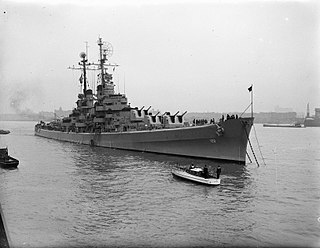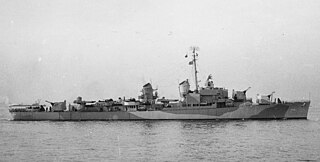
USS Wisconsin (BB-64) is an Iowa-class battleship built for the United States Navy (USN) in the 1940s and is currently a museum ship. Completed in 1944, the ship was assigned to the Pacific Theater during World War II, where she participated in the Philippines campaign and the Battles of Iwo Jima and Okinawa. The battleship shelled the Japanese home islands shortly before the end of the war in September 1945. During the Korean War, Wisconsin shelled North Korean targets in support of United Nations and South Korean ground operations, after which she was decommissioned. She was reactivated in 1986; after a modernization program, she participated in Operation Desert Storm in January – February 1991.

The first USS Saipan (CVL-48/AVT-6/CC-3) was a light aircraft carrier of the United States Navy, the lead ship of her class of carrier. She was later selected for conversion into a command ship in 1963–1964, but instead of becoming a command ship she was converted to the Major Communications Relay Ship Arlington (AGMR-2) in 1965.

USS Manchester was a Cleveland-class light cruiser of the United States Navy, which were built during World War II. The class was designed as a development of the earlier Brooklyn-class cruisers, the size of which had been limited by the First London Naval Treaty. The start of the war led to the dissolution of the treaty system, but the dramatic need for new vessels precluded a new design, so the Clevelands used the same hull as their predecessors, but were significantly heavier. The Clevelands carried a main battery of twelve 6-inch (152 mm) guns in four three-gun turrets, along with a secondary armament of twelve 5 in (127 mm) dual-purpose guns. They had a top speed of 32.5 knots.

The second USS Fresno (CL-121) was a United States Navy Juneau-class light cruiser launched on 5 March 1946 by Federal Shipbuilding and Dry Dock Company of Kearny, New Jersey, sponsored by Mrs. Ruth R. Martin; and commissioned on 27 November 1946, with Captain Elliott Bowman Strauss in command. She was reclassified CLAA-121 on 18 March 1949.

USS Galveston (CL-93/CLG-3) was a Cleveland-class light cruiser of the United States Navy that was later converted to a Galveston-class guided missile cruiser. She was launched by William Cramp & Sons Shipbuilding Company, Philadelphia 22 April 1945, sponsored by Mrs. Clark Wallace Thompson. The cruiser's construction was suspended when nearly complete on 24 June 1946; and the hull assigned to the Philadelphia Group of the Atlantic Reserve Fleet. She was reclassified CLG-93 on 4 February 1956; then reclassified to CLG-3 on 23 May 1957; and commissioned at Philadelphia 28 May 1958.

USS Providence (CL-82/CLG-6/CG-6) was a Cleveland-class light cruiser and the fourth ship of the United States Navy to be named after the city of Providence, Rhode Island. Providence was commissioned between 1945 and 1949. From 1957 to 1959, she was converted to a guided missile cruiser and flagship. She served in that role from 1959 to 1973. After her decommissioning, she was finally scrapped in 1980.

The third USS Rochester (CA-124), an Oregon City-class heavy cruiser, was laid down 29 May 1944 by Bethlehem Steel Co., Quincy, Massachusetts; launched 28 August 1945; sponsored by Mrs. M. Herbert Eisenhart, wife of the president of Bausch & Lomb Optical Co., Rochester, New York; and commissioned 20 December 1946 at the Boston Navy Yard.

USS Higbee (DD/DDR-806) was a Gearing-class destroyer in the United States Navy during World War II. She was the first U.S. warship named for a female member of the U.S. Navy, being named for Chief Nurse Lenah S. Higbee (1874–1941), a pioneering Navy nurse who served as Superintendent of the U.S. Navy Nurse Corps during World War I.

USS Douglas H. Fox (DD-779) was an Allen M. Sumner-class destroyer of the United States Navy.

USS Spokane (CL-120/CLAA-120/AG-191) was the second ship of the Juneau-class light cruiser of the United States Navy.

USS Springfield was a Cleveland-class light cruiser of the United States Navy, which were built during World War II. The class was designed as a development of the earlier Brooklyn-class cruisers, the size of which had been limited by the First London Naval Treaty. The start of the war led to the dissolution of the treaty system, but the dramatic need for new vessels precluded a new design, so the Clevelands used the same hull as their predecessors, but were significantly heavier. The Clevelands carried a main battery of twelve 6-inch (152 mm) guns in four three-gun turrets, along with a secondary armament of twelve 5 in (127 mm) dual-purpose guns. They had a top speed of 32.5 knots.

USS Worcester (CL-144) was a light cruiser in the United States Navy, and the third ship to carry that name, honoring the city of Worcester, Massachusetts. Worcester was the lead ship of the Worcester-class of light cruisers. She was launched just after the close of World War II, and decommissioned in 1958.

USS Taylor (DD/DDE-468) was a Fletcher-class destroyer of the United States Navy, named for Rear Admiral William Rogers Taylor (1811–1889). She was laid down on 28 August 1941 at Bath, Maine, by the Bath Iron Works Corp.; launched on 7 June 1942, sponsored by Mrs. H. A. Baldridge; and commissioned on 28 August 1942 at the Charlestown Navy Yard near Boston, Mass.

USS John D. Ford (DD-228/AG-119) was a Clemson-class destroyer in the United States Navy during World War II. She was named for Rear Admiral John Donaldson Ford.

USS Ingraham (DD-694) was a United States Navy Allen M. Sumner-class destroyer, the third ship in U.S. Navy history to be named for Duncan Ingraham. She was in commission from 1944 to 1971. Following her US service, she was sold to the Hellenic Navy and renamed Miaoulis. The ship was sunk as a target in 2001.

USS Lyman K. Swenson (DD-729), an Allen M. Sumner-class destroyer, was laid down on 11 September 1943 by Bath Iron Works, Bath, Maine and launched on 12 February 1944; sponsored by Miss Cecelia A. Swenson, daughter of Captain Swenson. The ship was commissioned at Boston Navy Yard on 2 May 1944.

USS John R. Pierce (DD-753), an Allen M. Sumner-class destroyer, is the only ship of the United States Navy to be named for Lieutenant Commander John Reeves Pierce.

USS Lowry (DD-770), an Allen M. Sumner-class destroyer, is the only ship of the United States Navy to be named for Reigart Bolivar Lowry, who served in the Mexican–American War and was a member of Commodore Matthew C. Perry's expedition to Japan in 1855. He served with distinction in the American Civil War, capturing New Orleans and in the first attack on Vicksburg.

USS James C. Owens (DD-776), an Allen M. Sumner-class destroyer, is the only ship of the United States Navy FRAM II class to be named for Lieutenant James C. Owens Jr., a member of Torpedo Squadron 8 on board USS Hornet. His entire squadron was lost in an attack against Japanese aircraft carriers 4 June during the Battle of Midway. Lt. Owens received the Navy Cross and the Presidential Unit Citation (US) posthumously.

The Juneau-class cruisers were United States Navy light cruisers that were modified version of the Atlanta-class cruiser design. The ships had the same dual-purpose main armament as USS Oakland with a much heavier secondary antiaircraft battery, while the anti-submarine depth charge tracks and torpedo tubes were removed along with a redesigned superstructure to reduce weight and increase stability. Three ships were ordered and built, all completed shortly after World War II, but only Juneau remained active long enough to see action during the Korean War.




















